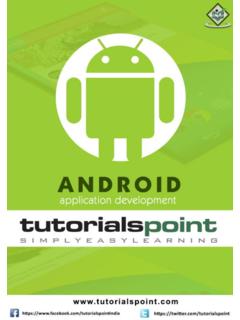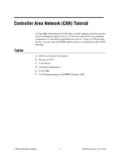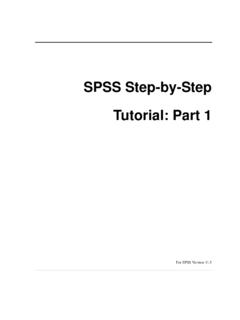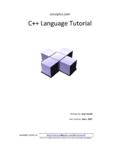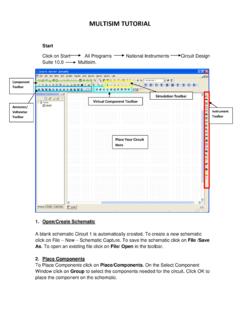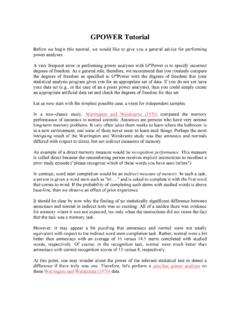Transcription of About The Tutorial
1 About The Tutorial C is a general-purpose, procedural, imperative computer programming language developed in 1972 by Dennis M. Ritchie at the Bell Telephone Laboratories to develop the UNIX operating system. C is the most widely used computer language. It keeps fluctuating at number one scale of popularity along with Java programming language, which is also equally popular and most widely used among modern software programmers. Audience This Tutorial is designed for software programmers with a need to understand the C. programming language starting from scratch. This Tutorial will give you enough understanding on C programming language from where you can take yourself to higher level of expertise. Prerequisites Before proceeding with this Tutorial , you should have a basic understanding of Computer Programming terminologies.
2 A basic understanding of any of the programming languages will help you in understanding the C programming concepts and move fast on the learning track. Copyright & Disclaimer Copyright 2014 by tutorials Point (I) Pvt. Ltd. All the content and graphics published in this e-book are the property of tutorials Point (I). Pvt. Ltd. The user of this e-book is prohibited to reuse, retain, copy, distribute or republish any contents or a part of contents of this e-book in any manner without written consent of the publisher. We strive to update the contents of our website and tutorials as timely and as precisely as possible, however, the contents may contain inaccuracies or errors. tutorials Point (I) Pvt. Ltd. provides no guarantee regarding the accuracy, timeliness or completeness of our website or its contents including this Tutorial .
3 If you discover any errors on our website or in this Tutorial , please notify us at i Table of Contents About The Tutorial .. i Audience .. i Prerequisites .. i Copyright & Disclaimer .. i Table of Contents .. ii 1. OVERVIEW .. 1. Facts About C .. 1. Why Use C? .. 1. C 2. 2. ENVIORNMENT SETUP .. 3. Try it Option Online .. 3. Local Environment Setup .. 3. Text Editor .. 3. The C Compiler .. 4. Installation on UNIX/Linux .. 4. Installation on Mac OS .. 5. Installation on Windows .. 5. 3. PROGRAM STRUCTURE .. 6. Hello World Example .. 6. Compile and Execute C Program .. 7. 4. BASIC SYNTAX .. 8. Tokens in 8. 8. Comments .. 8. Identifiers .. 9. ii Keywords .. 9. Whitespace in C .. 10. 5. DATA 11. Integer Types .. 11. Floating-Point Types .. 13. The void 14. 6. 15. Variable Definition in C .. 15.
4 Variable Declaration in 16. Lvalues and Rvalues in C .. 18. 7. CONSTANTS AND LITERALS .. 19. Integer Literals .. 19. Floating-point Literals .. 20. Character Constants .. 20. String Literals .. 21. Defining Constants .. 22. The #define Preprocessor .. 22. The const Keyword .. 23. 8. STORAGE 24. The auto Storage Class .. 24. The register Storage Class .. 24. The static Storage Class .. 25. The extern Storage Class .. 26. 9. 28. Arithmetic Operators .. 28. Relational Operators .. 30. iii Logical Operators .. 32. Bitwise Operators .. 34. Assignment Operators .. 37. Misc Operators sizeof & ternary .. 40. Operators Precedence in C .. 41. 10. DECISION MAKING .. 45. if Statement .. 46. if else Statement .. 48. Statement .. 49. Nested if Statements .. 51. switch Statement .. 53. Nested switch Statements.
5 55. The ? : Operator: .. 57. 11. LOOPS .. 58. while Loop .. 59. for Loop .. 61. do while Loop .. 63. Nested Loops .. 65. Loop Control Statements .. 67. break Statement .. 68. continue Statement .. 70. goto Statement .. 72. The Infinite Loop .. 74. 12. FUNCTIONS .. 76. Defining a Function .. 76. Function Declarations .. 77. iv Calling a Function .. 78. Function 79. Call by Value .. 80. Call by Reference .. 81. 13. SCOPE 84. Local Variables .. 84. Global Variables .. 85. Formal Parameters .. 86. Initializing Local and Global Variables .. 87. 14. ARRAYS .. 89. Declaring Arrays .. 89. Initializing Arrays .. 89. Accessing Array Elements .. 90. Arrays in Detail .. 91. Multidimensional Arrays .. 92. Two-dimensional Arrays .. 92. Initializing Two-Dimensional Arrays .. 93. Accessing Two-Dimensional Array Elements.
6 93. Passing Arrays to Functions .. 94. Return Array from a Function .. 96. Pointer to an Array .. 99. 15. POINTERS .. 101. What are Pointers? .. 101. How to Use Pointers?.. 102. NULL Pointers .. 103. Pointers in Detail .. 104. Pointer Arithmetic .. 104. Incrementing a Pointer .. 105. v Decrementing a Pointer .. 106. Pointer Comparisons .. 107. Array of Pointers .. 108. Pointer to Pointer .. 110. Passing Pointers to Functions .. 112. Return Pointer from Functions .. 114. 16. STRINGS .. 117. 17. STRUCTURES .. 120. Defining a Structure .. 120. Accessing Structure Members .. 121. Structures as Function Arguments .. 122. Pointers to Structures .. 124. Bit Fields .. 126. 18. UNIONS .. 128. Defining a Union .. 128. Accessing Union Members .. 129. 19. BIT FIELDS .. 132. Bit Field Declaration .. 133.
7 20. TYPEDEF .. 136. typedef vs #define .. 137. 21. INPUT AND 139. The Standard Files .. 139. The getchar() and putchar() Functions .. 139. The gets() and puts() Functions .. 140. The scanf() and printf() Functions .. 141. 22. FILE 143. vi Opening Files .. 143. Closing a File .. 144. Writing a 144. Reading a File .. 145. Binary I/O Functions .. 146. 23. PREPROCESSORS .. 147. Preprocessors 148. Predefined 148. Preprocessor Operators .. 150. The Macro Continuation (\) Operator .. 150. The Stringize (#) Operator .. 150. The Token Pasting (##) Operator .. 150. The Defined() Operator .. 151. Parameterized Macros .. 152. 24. HEADER FILES .. 153. Include 153. Include Operation .. 153. Once-Only Headers .. 154. Computed Includes .. 155. 25. TYPE CASTING .. 156. Integer Promotion .. 157. Usual Arithmetic 157.
8 26. ERROR HANDLING .. 160. errno, perror(), and strerror() .. 160. Divide by Zero 161. Program Exit 162. vii 27. RECURSION .. 164. Number Factorial .. 164. Fibonacci Series .. 165. 28. VARIABLE ARGUMENTS .. 167. 29. MEMORY MANAGEMENT .. 170. Allocating Memory Dynamically .. 170. Resizing and Releasing Memory .. 172. 30. COMMAND LINE ARGUMENTS .. 174. viii 1. OVERVIEW. C is a general-purpose, high-level language that was originally developed by Dennis M. Ritchie to develop the UNIX operating system at Bell Labs. C was originally first implemented on the DEC PDP-11 computer in 1972. In 1978, Brian Kernighan and Dennis Ritchie produced the first publicly available description of C, now known as the K&R standard. The UNIX operating system, the C compiler, and essentially all UNIX application programs have been written in C.
9 C has now become a widely used professional language for various reasons: Easy to learn Structured language It produces efficient programs It can handle low-level activities It can be compiled on a variety of computer platforms Facts About C. C was invented to write an operating system called UNIX. C is a successor of B language which was introduced around the early 1970s. The language was formalized in 1988 by the American National Standard Institute (ANSI). The UNIX OS was totally written in C. Today C is the most widely used and popular System Programming Language. Most of the state-of-the-art software have been implemented using C. Today's most popular Linux OS and RDBMS MySQL have been written in C. Why Use C? C was initially used for system development work, particularly the programs that make-up the operating system.
10 C was adopted as a system development language because it produces code that runs nearly as fast as the code written in assembly language. Some examples of the use of C might be: 9. Operating Systems Language Compilers Assemblers Text Editors Print Spoolers Network Drivers Modern Programs Databases Language Interpreters Utilities C Programs A C program can vary from 3 lines to millions of lines and it should be written into one or more text files with extension ".c"; for example, You can use "vi", "vim" or any other text editor to write your C program into a file. This Tutorial assumes that you know how to edit a text file and how to write source code inside a program file. 10. 2. ENVIORNMENT SETUP. Try it Option Online You really do not need to set up your own environment to start learning C programming language.






